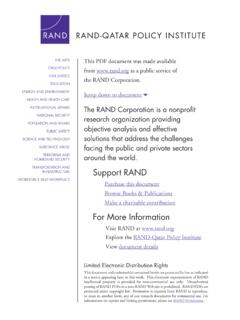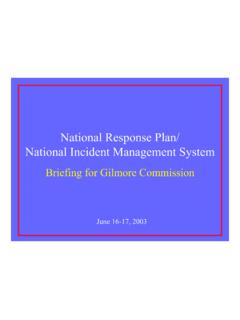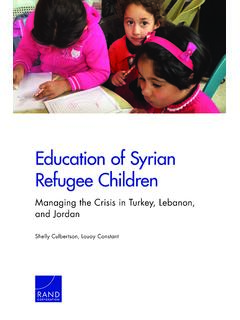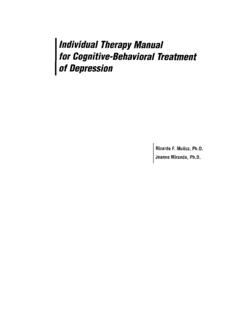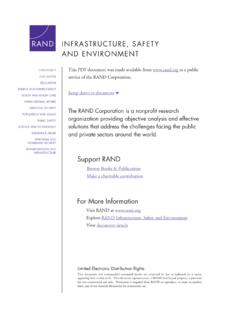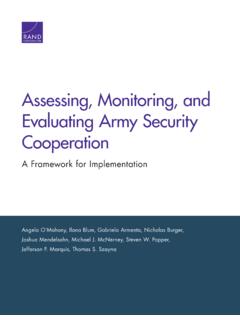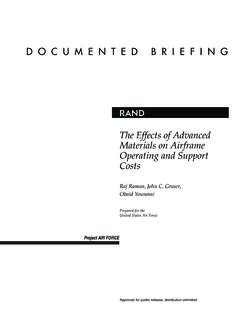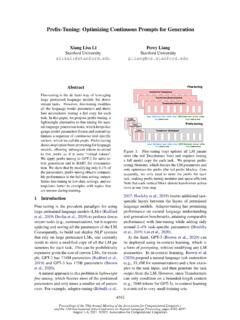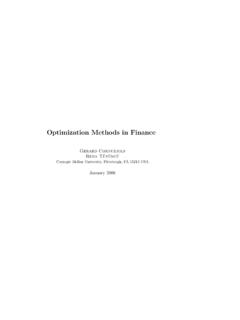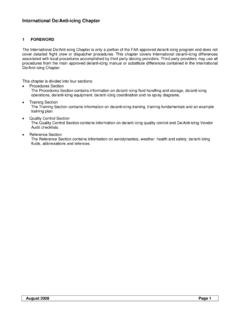Transcription of Assessing the Value of Structured Analytic Techniques in ...
1 C O R P O R AT I O N. Assessing the Value of Structured Analytic Techniques in the Intelligence Community Stephen Artner, Richard S. Girven, and James B. Bruce S U M M A RY The Intelligence Community (IC) is K e y findings strongly emphasizing the use of Structured Analytic tech- niques (SATs) to promote rigorous analysis, lessen the risk The Intelligence Community does not systematically evaluate the effectiveness of Structured Analytic tech- of intelligence failure, and make analysts' reasoning more niques, despite their increased use. transparent to consumers.
2 So far, however, the IC has made little effort to assess One promising method of Assessing these Techniques whether SATs in general or specific SATs are improving would be to initiate qualitative reviews of their contribu- tion in bodies of intelligence production on a variety of the quality of analysis. topics, in addition to interviews with authors, managers, One primarily qualitative method of evaluating these and consumers. Techniques would be periodic in-depth reviews of IC pro- duction on a variety of topics to ascertain how frequently A RAND pilot study found that intelligence publications SATs are used, whether they advance the attainment of using these Techniques generally addressed a broader range of potential outcomes and implications than did IC Analytic quality standards, and which specific SATs are other analyses.
3 Most effective. RAND's preliminary SAT review of a limited sample Quantitative assessments correlating the use of struc- of Central Intelligence Agency (CIA), Defense Intelligence tured Techniques to measures of Analytic quality, along with controlled experiments using these Techniques , Agency (DIA), and National Intelligence Council (NIC). could provide a fuller picture of their contribution to publications finds that the minority of them employing intelligence analysis. SATs addressed a broader range of potential outcomes and implications than did other analyses, although the logic behind specific Techniques was not always transparent.
4 More-comprehensive SAT reviews, along with interviews of analysts, managers, and consumers, could determine how effectively IC agencies are employing SATs and compile lessons learned on best practices and pitfalls of their use in intelligence analysis. In addition, quantitative research could examine the extent to which the use or nonuse of SATs correlates with the quality of Analytic output as measured by the Office of the Director of National Intelligence's (ODNI's) Office of Analytic Integrity and Standards and by individual agencies, while controlled experiments could test the use of SATs under conditions similar to those prevailing in the IC.
5 2. evaluation of each through the examination of evidence I NTRO DUCTI O N and data that applies to them all, and the selection of the In recent years, the IC has greatly increased its use of SATs to most explanatory or best-fitting hypothesis (or hypoth- promote rigorous analysis, lessen the risk of intelligence failure, eses) by focusing on information that tends to disconfirm and make analysts' reasoning more transparent to consum- weaker hypotheses ers. So far, however, the IC has made little effort to assess the indicators a preestablished set of observable phenomena impact of SATs on the quality of intelligence analysis.
6 This that are periodically reviewed to help track events, spot report outlines a research design for systematically reviewing emerging trends, and warn of unanticipated changes. the use of SATs in IC-wide finished production to assess their Value in general and the utility of particular SATs for address- SATs provide analysts with clear, often step-by-step, guid- ing various types of intelligence issues. Introducing a variant ance for conducting analysis of intelligence issues. By providing of the Analytic line review, we propose SAT reviews on discrete greater structure to the Analytic process, they reduce subjectiv- bodies of IC work and present a pilot project on a limited sam- ity and add both rigor and transparency to analysis.
7 A key part ple of IC finished production. The pilot project was intended of reducing subjectivity in analysis requires identifying cogni- to illustrate how broader SAT reviews could draw conclusions tive bias and reducing it. Chief among such biases often seen in regarding the overall Value of SATs, the extent of their utiliza- intelligence analysis are tion in IC analysis, the suitability of particular SATs to specific confirmation bias a tendency to search for or interpret problem sets, possible disadvantages of SATs, best practices in information in ways that confirm preconceptions, prefer- their use, and the need for additional Analytic methodologies.
8 Ences, and assumptions, while downplaying or discredit- The report also proposes several other approaches the IC could ing alternative or less-agreeable explanations that tend not utilize to evaluate the effectiveness of SATs and optimize their to confirm the preferred explanation or interpretation of use in finished production. events mirror imaging an inclination to assume that foreign leaders would behave pretty much as we imagine our own What Are Structured Analytic Techniques , leaders would behave in similar circumstances, especially and Why Do Analysts Use Them?
9 When the stakes are high if major errors are made in ratio- SATs are methods of organizing and stimulating thinking nal decisionmaking about intelligence problems. These methods aim to make the anchoring a tendency to anchor analysis in the first or Analytic process conscious and transparent, thus reducing earliest important piece of information considered, so that the probability of errors caused by numerous cognitive biases later changes in judgments are typically small and rarely that go unchallenged in unstructured and intuitive analysis. stray far from the initial judgment According to an unclassified government guide to Analytic groupthink a usually subconscious preference for group tradecraft,1 SATs fall into three broad categories: Diagnostic consensus favoring agreement among group members and Techniques aim to make assumptions and logical arguments subtly discouraging alternative views and interpretations, more transparent; contrarian Techniques challenge current which are often seen as efforts to disrupt the consensus the thinking.
10 And imaginative thinking Techniques encourage new other members desire. perspectives, insights, and alternative scenarios. Among the many SATs in use today, the most common are In addition to their significant debiasing capabilities, SATs Structured brainstorming a group discussion process used also provide step-by-step guidance for designing analysis to for generating new ideas and concepts often used to kick address particular kinds of problems. They make analysis much off analysis of especially complex or controversial issues more transparent, so that other analysts and customers can bet- key assumptions check a systematic effort to make explicit ter understand how the judgments were reached.

